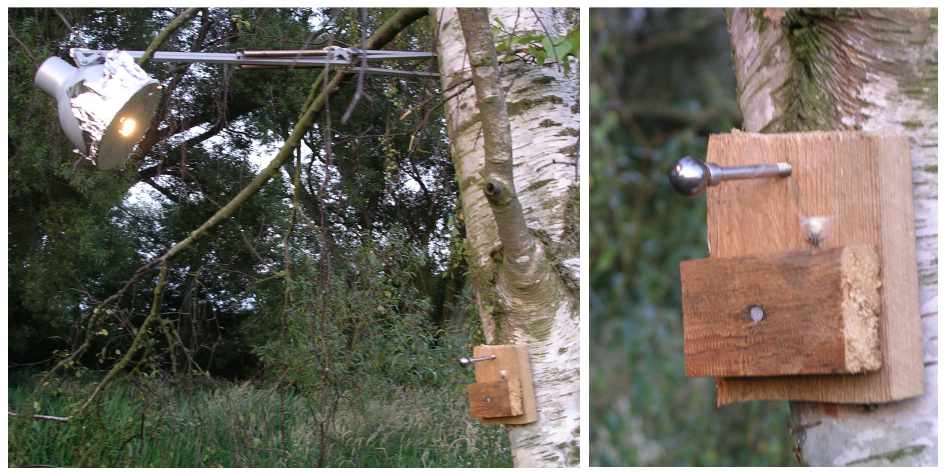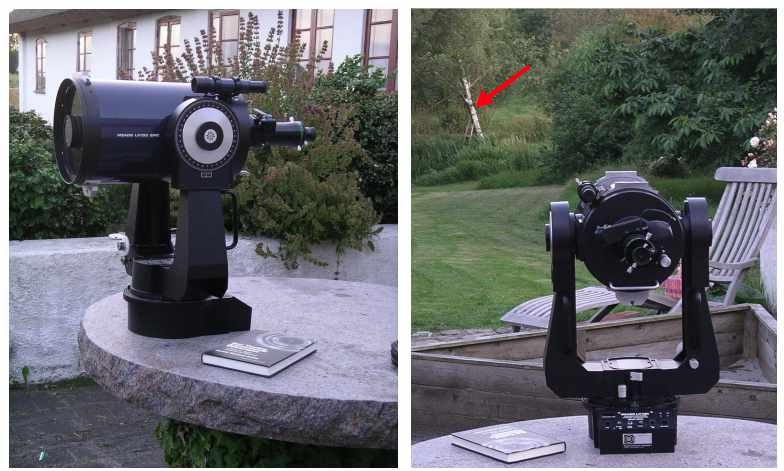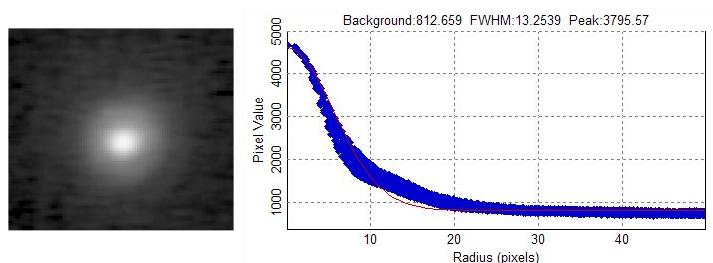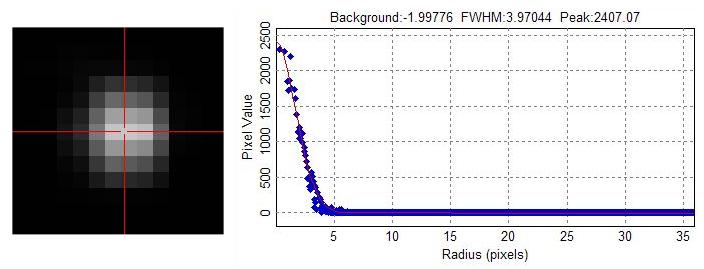

Accurate collimation is important for obtaining the highest image quality. Although the sky is full of stars suitable as targets when collimating, I chose to learn the process using an 'artificial star'. This is merely an illuminated reflective sphere situated at a minimum distance from the telescope. In this way I was independent of clear skies and seeing, the latter which often prevents the most accurate adjustments from being made. A detailed description of the construction and use of artificial stars is provided in the excellent book 'Star Testing Astronomical Telescopes', by Harold Suiter. Also, be sure to check out Thierry Legault's great web site where this topic is covered.

Above you can see the artificial star I used. It consists of a half-inch steel ball bearing glued to a screw that is mounted on a tree. The ball bearing is illuminated by a lamp-mounted 100 W lightbulb. The lamp is covered with a metal foil sheet that has a 1-inch hole in it. To increase the intensity of the illumination I also put reflective foil on the inside of the lamp. This arrangement is placed ~70 meters from the telescope. The ball bearing diameter, the lamp illumination and the telescope distance were chosen according to Suiters book so that the reflective spot subtends an angle that is less than the telescopic resolution.
On my 8" SCT I used a x4 Televue Powermate and a 9 mm Plössl eyepiece to achieve a magnification of 890x. Such a large magnification facilitates viewing of fine details in the near/in-focus Airy pattern which are required to achieve the highest degree of collimation. There are very few nights with a seeing which would permit such a high magnification on a real star. With my artificial star the amount of air, and hence the amount of turbulence, between me and the target is much less. On my 4" ED refractor I could not reach focus with the x4 Powermate, instead I had to make do with a x1.8 Barlow, yielding a magnification of 128x with the 9 mm plössl.
I collimated each telescope in the usual manner visually (centering of Airy rings, equal intensity all the way around). Afterwards, I'd like to document the performance, so I replaced the eyepiece with a ToUcam webcam. On the webcam I had mounted a green interference filter (SBIG) which also had an IR block so that chromatic variations (either in abberation or diffraction) would be greatly minimized. This makes the Airy rings more apparent. With the SCT the image scale was 0.14 arcsec/pixel. With careful focussing, several runs and automatic selection and stacking of the sharpest frames using K3CCDtools I obtained the result shown below:

The image above was zoomed 2x, i.e. the image scale is just 0.07 arcsec/pixel. A gamma histogram strech was applied to the image at left to bring out faint Airy ring details. The first Airy ring is visible, although not clearly defined. Of the second Airy ring just a faint arc is visible at 3-5 o'clock. The measured FWHM is 0.8 arcsec. The calculated FWHM due to diffraction alone (1.22*lambda/D) is 0.7 arcsec, i.e. very close to the value that I measure. The additional 15% I get can easily be due to air turbulence and inaccurate focussing (done manually with the standard SCT knob). The presence of the secondary mirror - and abberations - is evident by the intensity of the first Airy ring, which is larger than that of an ideal 8" aperture with a central obstruction diameter of 37% of the full aperture. I have not yet investigated the details of this, nor what it means for the performance, and would like some more collimation runs to be sure I am doing things right. The effect of spreading light from the inner Airy disc into the rings is to reduce the contrast of extended sources, such as planetary discs (see for example: M.D. Russell, Sky & Telescope, March 1995, and Legault's discussion on the web).
Below is the webcam image I got with the 4" refractor, after final collimation adjustments:

Since I could not use the x4 Powermate the point spread function is undersampled (diffraction limit is
1.2 arcsec, image scale on webcam is 1 arcsec/pixel). The measured FWHM is 2.0 arcsec, which agrees plainly
with this limitation. In future attempts I should try to get a higher magnification on the webcam so that the
actual resolution can be measured.
Here's my main page where you can see more of work I have done so far.
Comments greatly appreciated! (mikael@leif.org)